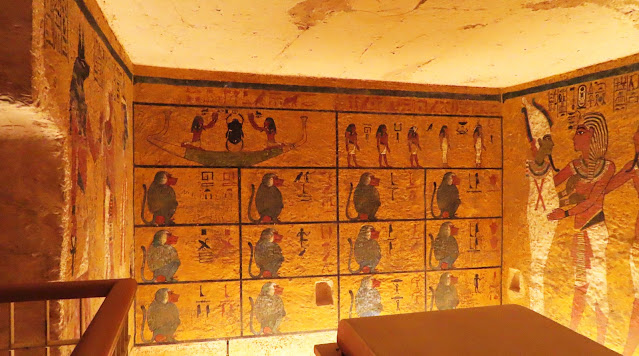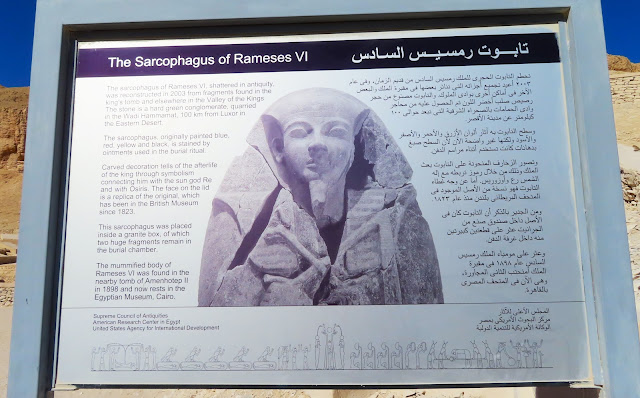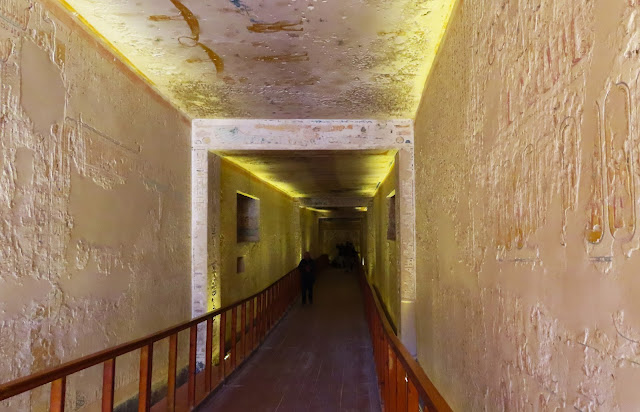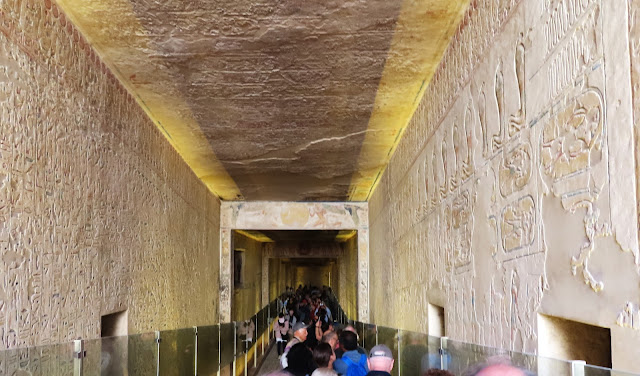February 14, 2023
The Valley of the Kings, the Temple of Hatshepsut, the Colossi of Memnon, and Cruising Down the Nile
The Valley of the Kings is a network of canyons winding its way through the soft limestone hills on the west bank of the Nile just across the Nile River from Karnak and Luxor. It is famous as the necropolis of the pharaohs of the New Kingdom. Pharaohs of the Old Kingdom were buried in pyramids. Those of the Middle Kingdom were scattered in various separate locations. But the pharaohs of the New Kingdom, (18th – 22nd Dynasties), in their attempt to prevent grave-robbers from taking the precious possessions the kings would need in the afterlife, chose to have their burial chambers buried deep into the sides of the mountains. The location was supposed to be kept secret, but the secret got out, and every one of the sixty-two tombs here were plundered – with one famous exception. Young King Tut remained in his burial tomb with his possessions until his discovery by a young boy in 1922.
There is also a symbolic significance to the location of this valley. Karnak, the great temple of Amon Ra, the sun god, stands on the east side of the Nile, greeting the rising sun, while the Valley of the Kings sits on the west side, the tombs of the pharaohs lying under the glow of the setting sun.
We met our wonderful guide, Deda, first thing in the morning and boarded one of the many colorful boats ferrying visitors across the Nile. Our driver was waiting on the other side to drive us the short distance to the entrance to the site.
On the way to the valley, we passed by the home of archaeologist Howard Carter during his work here in the 1920s and 30s. Carter, funded by his patron, Lord Carnarvon, had been digging in this valley for several years. He found nothing but empty tombs, and Lord Carnarvon, who was tired of getting no results, had given him notice that 1922 would be the last season. Then in November of that year, a boy who worked on the excavation team was inside of the tomb of Rameses VI and dropped a jar of water. The water immediately vanished through the floor, so the young man went running for Carter with the news that there must be another chamber below the floor. Tutankhamen’s burial location had remained hidden because King Ramses VI’s much larger tomb was built just over the tomb of the rather insignificant young Pharoah, who died at the age of nineteen. His is the one and only intact tomb discovered in the Valley of the Kings. (There were additional intact tombs discovered by French archaeologist, Pierre Montet, in the ancient city of Tanis.)
The Visitors Center had some helpful exhibits, including a 3-D map of the valley, showing the location of the excavated tombs. I loved the model showing each of the tombs UNDER the ground so we could see how they were placed relative to each other.
The Tomb of King Tut Ankh Amun
Many of the tombs are open to the public, but Deda had arranged for us to visit the “extra-ticket-required” tombs of both Tutankhamen and Ramses VI. We walked down some steep stairs to the lower tomb of King Tut and entered the short passageway that leads to his small burial chamber and the adjoining room that had once held his treasures.
 |
| Rob outside of the Tomb of Tut Ankh Amun |
 |
| A diagram of Tut's tomb and descriptions of the paintings on the walls of his burial chamber. |
The still vivid paintings on the walls tell the story the Imy Dwat, the mystical journey of the soul from the earthly plane to the realm of the afterlife.
 |
| The panels on the walls show rituals and spells from The Book of the Dead. The First Hour of the Imy Dwat depicts baboons and Egyptian deities. |
 |
| The first three figures on the left show Tut, in the middle, being greeted by Osiris and Nut. |
 |
| This shows King Ay as a priest performing the Opening of the Mouth ritual for Tut as Osiris. |
 |
| The Funeral Procession from the Book of the Dead, Spell One |
Imagine the joy and excitement of the team that uncovered the hidden tomb, filled with over 3,000 artifacts, including Tut’s golden throne, his sarcophagus, and the three nested coffins inside that held his mummy. The coffins and treasures now lie in the Egyptian Museum in Cairo, but his remarkably well-preserved mummy and the stone sarcophagus remain in his final resting place.
 |
| The large sarcophagus that held the three nested coffins of King Tut |
I was surprised to see that his mummy still lies here! I felt sad as I looked that his young face, but I also thought that perhaps he, more than any other pharaoh, attained eternal life because all the world still knows of him.
The Tomb of Rameses VI
Just above Tut’s small tomb, we entered the much larger tomb of Rameses VI.
 |
| Pharaoh Rameses VI - This sign discussed the partial restoration of his sarcophagus which we saw inside his tomb. |
 |
| Diagram of Rameses' tomb, which is much larger than Tut's. |
We walked deep into the mountain to the much larger burial chamber with adjoining rooms…all empty – except for the sarcophagus - and the art!
 |
| The walls toward the entrance to the tomb were plain and nearly bare... |
 |
| ...but as we went deeper into the tomb, we began to see colors and designs everywhere. |
At the bottom of the tunnel was the burial chamber and broken sarcophagus of Rameses VI.
The biggest thrills of this visit were the vivid, colorful paintings and engravings still on the walls. Hieroglyphs telling about the accomplishments of the pharaohs, large images of the kings and the gods, cartouches showing their names, animals, barges, servants, soldiers covered every inch of the walls of the hallway, ceilings, and chambers.
In both tombs, the burial chamber scenes are about Imy dwat, the journey to the afterlife. Everyone’s journey ends with a series of questions by several juries of the gods. Then the heart of the person (the one organ left in the body following mummification) is balanced on a scale with the heart on one side of the scale and a feather on the other. If a person had done good works, his heart would be lighter than a feather and he would continue to eternal life. If evil, his heavy heart would spell his doom.
Most of this fabulous artwork is almost perfectly preserved, hiding for years in dark caverns in a dry desert climate. What a treasure for us!
The Tomb of Rameses IX
We also visited one of the “public” tombs, that of Rameses IX, which was also interesting, although not quite as spectacular as the other two.
The Temple of Hatshepsut, the Pharaoh Queen
The Valley of the Kings was just the start of our day. Our next stop was the Temple of Hatshepsut, the first female pharaoh. Her story is remarkable, and a little complicated, so try to follow along on her little soap opera!
 |
| We had seen Hatshepsut's face in the Egyptian Museum. She wears the ceremonial beard to demonstrate her power as pharaoh. |
 |
| Hatshepsut's face on one of the Sphinxes along the path to her temple. |
Hatshepsut was the daughter of King Thutmose I and his royal wife. But Tutmosis also had a son with his other wife, a non-royal woman. His son could not be pharaoh unless descended from a royal mother – or unless he married a royal woman – so he married his half-sister, Hatshepsut, and became Thutmose II.
 |
| Thutmose II |
 |
| Hatshepsut |
It gets even more fun from here! Thutmose II and Hatshepsut had a daughter named Nefru (royal but not eligible to be pharaoh), and he and his other non-royal wife had a son, another Thutmose. Solution? Young Tutmosis married young Nefru and became Thutmose III. So notice that young Thutmose was Hatshepsut’s stepson, nephew, AND son-in-law!
Thutmose III was too young to rule, so Hatshepsut became regent, ruling in his place until his majority, but she must have enjoyed the power because after three years, she declared herself to be the daughter of Amun Ra, the mighty sun god. How could she get away with this? Her powerful and loyal priest, Senenmut, (who is also rumored to have been her lover), declared that the gods had selected her. and she reigned as pharaoh for nineteen years!
Senenmut designed a huge temple for her. The design is unique among Egyptian temples and reminds one of the columned buildings of Greece and Rome, but in fact, the Greeks and Romans got the inspiration for THEIR columns from the ones in this temple.
We walked up the two sets of steps to the temple, and Deda explained the artwork carved into the walls. One of her greatest accomplishments was sending an expedition to Puntland (Somalia) to establish a trade route. Egypt exchanged gold in return for ivory, leopard skins (worn by the priests), and Arabic gum, a crucial ingredient in mummification.
 |
| Faint engraving of an antelope and hieroglyphics |
 |
| A tribute to the trade route to Puntland established by Hatshepsut |
 |
| Because these paintings were on wall that were exposed to the air outside, so they are not well-preserved, but these also pay tribute to Hatshepsut's many accomplishments. |
In the manner of some later Roman emperors, her son tried to erase her name from history and take credit for her accomplishments. We saw on the walls of her temple where he had her image scratched out. But the temple and various statues remain. The statues are interesting because they are the face of a woman sporting the ceremonial beard, which indicated her status as a powerful pharaoh.
In spite of his revenge against his mother for taking power, Tutmosis III went on to become one of the greatest pharaohs in history. He ruled for forty years and expanded the boundaries of Egypt from Iraq to Libya to South Sudan.
We visited the cafe near the entrance to the Temple for some refreshment before continuing with the day's explorations.
The Colossi of Memnon
A little further down the road, we made two quick stops before returning to our cruise ship. Standing in a small field were two enormous statues known as the Colossi of Memnon, both depicting Pharaoh Amenhotep III. They were built around 1350 BC, and stood in front of his mortuary temple, the largest temple in the Necropolis of Thebes.
The temple was destroyed and the statues were badly damaged by a huge earthquake around 1200 BC. This area (called Thebes by the Greeks) was well-known to both the Greeks and the Romans, and for some reason, they associated this statue with a hero from the Trojan War, Memnon. The large cracks in one of the statues whistle and wail when the wind blows through them, so the Greeks had the story that the mother of Memnon was crying for her lost son.
 |
| The South Colossus |
 |
| The North Colossus. The wind whistling through the cracks in the stone of this statue cause it to moan and "cry." |
Alabaster Artisans
Our last stop was at a shop where artisans were creating items out of alabaster, a soft calcite or gypsum stone that has been used throughout history for carving beautiful objects.
The artisans were using traditional methods to grind out the centers of rocks of alabaster to create vases and other vessels. We got to try some of the tools ourselves, then went into the store to browse through the finished products. The shop owner demonstrated how a light inside of the vessel glows through the translucent stone and clearly shows the beautiful darker swirls in the alabaster. We purchased a lovely vase, a nice souvenir of our trip.
Cruising the Nile River
When we returned to our ship to "set sail" from Luxor, we found that Mahmoud, our room steward, had left our new towels folded in the shape of a boat. Very appropriate for an afternoon of cruising! For the rest of the day, we joined many other cruise ships in watching the sights or rural Egypt along the Nile, the river that gives life to the country. Just over the low hills is nothing but desert sand all the way across northern Africa.
 |
| A boat on our bed |
 |
| The Moon Goddess was just one of the many boats that cruise the Nile River |
 |
| A felucca |
 |
| Cows graze on the grasses along the Nile... |
 |
| ...and so do the goats |
 |
| The minaret of a village mosque |
In the middle of the night, we were awakened by loud voices on the shore working on the docks of the lock that would lift ship up to the higher level of the Nile as we cruised south to Upper Egypt and more adventures.



























































No comments:
Post a Comment